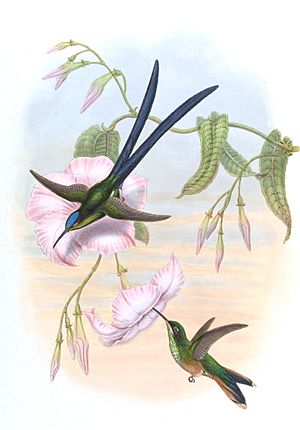Scissor-tailed Hummingbird facts for kids
The scissor-tailed hummingbird (Hylonympha macrocerca) is a special type of hummingbird. It is found only in the country of Venezuela in South America. This tiny bird lives in forests that are moist and found on mountains, in areas that are either subtropical or tropical.
Quick facts for kids Scissor-tailed Hummingbird |
|
|---|---|
 |
|
| Scientific classification | |
| Kingdom: | |
| Phylum: | |
| Class: | |
| Order: | |
| Family: | |
| Genus: |
Hylonympha
Gould, 1873
|
| Species: |
H. macrocerca
|
| Binomial name | |
| Hylonympha macrocerca Gould, 1873
|
|
Contents
About the Scissor-tailed Hummingbird
The scissor-tailed hummingbird gets its name from its long, forked tail, which looks a bit like a pair of open scissors. These birds are very small and known for their amazing ability to hover in the air. They can even fly backward!
Where They Live
This hummingbird lives only in a specific part of Venezuela. It prefers mountainous areas where the air is humid and the forests are lush. These forests are often called "cloud forests" because they are frequently covered in mist or clouds. This special habitat provides the food and shelter the hummingbirds need.
What They Eat
Like other hummingbirds, the scissor-tailed hummingbird mainly drinks nectar from flowers. Nectar is a sweet liquid that gives them lots of energy to fly. They also eat tiny insects. Insects provide them with important protein that they need to stay healthy.
Protecting This Special Bird
The scissor-tailed hummingbird is a very rare bird. It is threatened because its home is slowly disappearing. This is called habitat loss.
Why Habitat Loss is a Problem
Habitat loss happens when forests are cut down for farming, building, or other human activities. When the forests are gone, the hummingbirds lose their homes, their food sources, and places to raise their young. This makes it very hard for them to survive.
Conservation Status
Because of these threats, the scissor-tailed hummingbird is listed as an "Endangered" species. This means it is at a very high risk of disappearing forever.
- Vulnerable: At first, in 2004, the IUCN thought it was "Vulnerable." This means it was facing a high risk of extinction.
- Endangered: But new studies showed that there were even fewer of these birds than people thought. So, in 2008, its status was changed to "Endangered." This is a more serious warning, showing that we need to do more to protect them.
Protecting these unique birds and their forest homes is very important.
See also
 In Spanish: Colibrí tijereta para niños
In Spanish: Colibrí tijereta para niños

